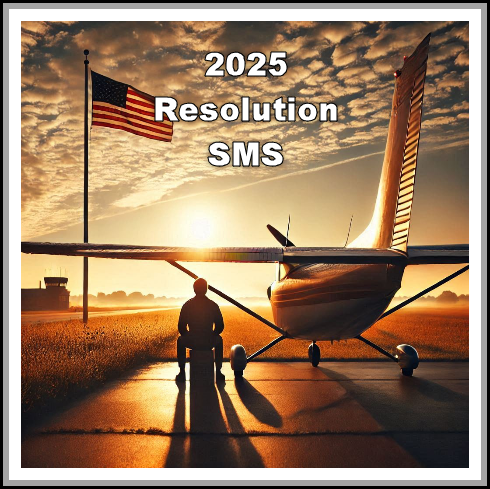FAA SMS for GA- reasons to JUST DO IT!!!

Below, the FAA has repeated a theme that has dominated its (ICAO’s. EASA’s and most CAA’s) safety regime. This INFORMATION FOR OPERATORS was directed at General Aviation and the applicability of the Safety Management System (SMS) to this segment of flight.
The accompanying trade press reported this announcement and devoted commentary to the reasons why SMS will not be burdensome. Rather than examining the “time cost” devoted to this preventative risk management, it is appropriate to FOCUS ON THE SAFETY BENEFITS FOR ALL WHO FLY.
Ask a professional working in aviation what their #1 priority is, and all will immediately announce SAFETY. That autonomic response may be proven inaccurate if the pilot, mechanic, controller, etc. sits down with an independent safety expert and reviews his/her actual practices. As explained in this excellent article, all humans, but in particular those who are involved repetitive routines like aviation are subject to “COGNITIVE BIASES”. The 2002 Nobel Memorial Prizewinner, Daniel Kahneman, was a psychologist whose study of how intuitive reasoning is flawed in predictable ways, provides tremendous insights of great relevance to all involved in safety.

What are these hidden aspects of behavior that impact our mental processes? Here are Kahneman’s seven unconscious affects –
- confirmation bias
- continuation/sunk cost bias
- outcome bias
- anchoring bias
- expectation bias
- framing bias
- ambiguity effect
[ use the link to learn the meanings of these influences on thinking.]
One of the preliminary steps in SMS is to survey the risks inherent in operations– equipment, maintenance, stick and rudder, physical and mental health, common weather challenges are the obvious ones. The above list of seven pose substantial potential risks—both from a bad historic practices and future awareness of those tendencies. “Yes, you were able to stick the landing, but did you recognize…?” is a question more likely to be honestly answered if posed by an expert. SMS assures that GA pilots and mechanics get the benefits of discovering their unconscious impacts on procedures. Proactively, the process is designed to reduce the likelihood of future repetition plus similar risks.
This is but one element of SMS and the other initial/ongoing steps CREATE benefits. It is common practice to plan businesses in a number of dimensions (strategy, finance, management, personnel, etc.). They follow a rubric that assures that the review is consistent and comprehensive. The return on this investment of the management’s time may not be calculable but are universally credited with financial success. IT IS AXIOMATIC THAT SAFETY HAS A LONG TERM CASUAL EFFECT ON AVIATION SUCCESS. As NIKE would say, JUST DO IT.


FAA Encouraging GA Safety Management Systems
New release recommends updating SMS standards to match those of EASA.

Earlier this month, the FAA issued an INFORMATION FOR OPERATORS (InFO) release encouraging general aviation organizations to develop and implement a voluntary Safety Management System (SMS) meeting current U.S. standards that are consistent with those of the International Civil Aviation Organization (ICAO). This InFO addresses an update published in April 2024 toward that goal, but did not adequately address issues related to operators of “large and turbojet aircraft operated internationally … as well as part 145 repair stations with European Union Aviation Safety Agency (EASA) authorizations.”
In the “discussion” section of the InFO, the FAA described an SMS as integrating “risk management into normal day-to-day business practices.” Under ICAO standards, an SMS is “commensurate with the size and complexity of the operation and meet the criteria established by the State of Registry.” ICAO recommends that a General Aviation SMS include processes to identify ACTUAL AND POTENTIAL SAFETY HAZARDS and assess associated risks, develop and implement REMEDIAL ACTION necessary to maintain an acceptable level of safety and include a provision for CONTINUOUS MONITORING AND REGULAR ASSESSMENT of the appropriateness and effectiveness of safety management activities.
The InFO concludes: “Aviation Organizations are encouraged to incorporate SMSs as a standard business practice regardless of type of aircraft operated.”


Excerpt
[for complete text, click on title link]
Discussion: An SMS integrates risk management into normal day-to-day business practices. Safety is managed as a core business function where the organization treats safety in the same way it manages other functions (e.g., financial, quality, marketing). ICAO standard states that GA operators of large aircraft (Gross Weight >12,500 lbs.) and turbojet aircraft must establish and maintain an SMS “commensurate with the size and complexity of the operation and meet the criteria established by the State of Registry.” ICAO recommends that GA SMS include:
• A process to identify actual and potential safety hazards and assess the associated risks; • A process to develop and implement remedial action necessary to maintain an acceptable level of safety; and
- A provision for continuous monitoring and regular assessment of the appropriateness and
- effectiveness of safety management activities.
Options for Aviation Organizations: A successful SMS implementation will require more than writing a manual. Aviation organizations may wish to use the services of third-party organizations to aid in development and implementation of their SMS. Operators should also determine what evidence of compliance is acceptable to the countries of intended operation.
